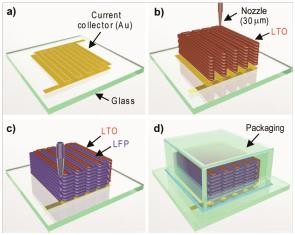The printed electronics industry has given recognition to materials scientists at Harvard University for their work on novel 3D printed lithium-ion microbatteries — batteries no bigger than a grain of sand. The 3D printed microbatteries, which could supply electricity to tiny devices in fields from medicine to communications, received the Academic R&D Award last month at the IDTechEx Printed Electronics USA 2013 event in Santa Clara, California.
According to the award description, Lewis’ research team at Harvard “has printed rechargeable 3D Li-ion micro-batteries composed of high–aspect ratio anode and cathode micro-arrays that are interdigitated on a sub-millimeter scale, and exhibit amongst the highest area energy and power densities reported to date. These micro-batteries occupy volumes less than 1mm cubed—equivalent in size to a single grain of sand—and are 1000 times smaller than the smallest commercially available rechargeable batteries.”
The batteries have a range of autonomous applications, including biomedical devices, micro-UAVs and distributed sensor arrays.

The award, recognising “innovation, success and development,” was presented to Jennifer A. Lewis, Hansjörg Wyss Professor of Biologically Inspired Engineering at Harvard School of Engineering and Applied Sciences (SEAS), and a Core Faculty Member of the Wyss Institute for Biologically Inspired Engineering at Harvard University. The category recognizes researchers who have “made a significant contribution over the past 24 months to the understanding of the principles and accrued knowledge behind printed electronics.”
The work was originally announced in June 2013 and published online in the journal Advanced Materials and was supported by the National Science Foundation and the DOE Energy Frontier Research Center on Light-Material Interactions in Energy Conversion.



